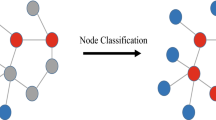Abstract
Graph convolutional neural networks (GCNs) introduced the idea of convolution into graph neural networks. It has been widely used in graph data processing in recent years. However, the current GCNs framework is not suitable for the task of handling complex relational graphs. For example, in node classification, too much dependence on node features leads to an over-smoothing phenomenon and high similarity between nodes, which affects the effect of node classification. To address this issue, we provide a new multi-channel attention graph convolutional neural network for node classification called SM-GCN. We have improved the accuracy of node classification through the following two aspects of work. (1) Alleviating the problem of over-reliance on a single feature by learning node features and topological structure node embeddings and applying both combinations. (2) Alleviating the over-smoothing by introducing scattering embeddings of topological structures to achieve band-pass filtering of different signals. Then, use the attention mechanism to apply the critical weights of embedding. Extensive experimental results on multiple datasets based on performance metrics demonstrate that the proposed method has superiority in improving the accuracy from 1 to 10% compared with the cutting-edge method and provides a novel scenario for the problem.



Similar content being viewed by others
Data availability
The data used to support the findings of this study are available from the corresponding author upon request.
References
Abu-El-Haija S, Perozzi B, Kapoor A, Alipourfard N, Lerman K, Harutyunyan H, Steeg GV, Galstyan A (2019) Mixhop: higher-order graph convolution architectures via sparsified neighborhood mixing. arXiv: 1905.00067
Wu J, He J, Xu J (2019) Demo-net: degree-specific graph neural networks for node and graph classification. In: ACM
Kipf TN, Welling M (2016) Variational graph auto-encoders. arXiv:1611.07308
You J, Ying R, Leskovec J (2019) Position-aware graph neural networks. In: International Conference on Machine Learning
Wang X, Zhu M, Bo D, Cui P, Shi C, Pei J (2020) AM-GCN: adaptive multi-channel graph convolutional networks. ACM
Kipf TN, Welling M (2016) Semi-supervised classification with graph convolutional networks. arXiv: 1609.02907
Franceschi L, Niepert M, Pontil M, He X (2019) Learning discrete structures for graph neural networks. arXiv: 1903.11960
Jin W, Derr T, Wang Y, Ma Y, Liu Z, Tang J (2021) Node similarity preserving graph convolutional networks. In: WSDM ’21: The Fourteenth ACM International Conference on Web Search and Data Mining
Li Q, Han Z, Wu MX (2018) Deeper insights into graph convolutional networks for semi-supervised learning. In: National Conference on Artificial Intelligence. arXiv:1801.07606
Gao F, Wolf G, Hirn M (2018) Geometric scattering for graph data analysis. arXiv: 1810.03068
Zou D, Lerman G (2018) Graph convolutional neural networks via scattering. Appl Comput Harmon Anal 49:1046–1074
Gama F, Ribeiro A, Bruna J (2018) Diffusion scattering transforms on graphs. In: The 7th International Conference on Learning Representations (ICLR)
Zhu H, Koniusz P (2021) Simple spectral graph convolution. In: International Conference on Learning Representation 2021
Min Y, Wenkel F, Wolf G (2020) Scattering GCN: overcoming oversmoothness in graph convolutional networks. In: The 34th Conference on Neural Information Processing Systems (NeurIPS 2020)
Qi JS, Liang X, Li ZY, Chen YF, Xu Y (2018) Representation learning of large-scale complex information network: concepts, methods and challenges. J Comput Sci 41(10):2394–2420
Bruna J, Zaremba W, Szlam A, Lecun Y (2013) Spectral networks and locally connected networks on graphs. Comput Sci
Defferrard M, Bresson X, Vandergheynst P (2016) Convolutional neural networks on graphs with fast localized spectral filtering. In: NeurIPS, pp 3844–3852
Kipf TN, Welling M (2016) Semi-supervised classification with graph convolutional networks. In: The 4th International Conference on Learning Representations (ICLR)
Xu B, Shen H, Cao Q, Qiu Y, Cheng X (2019) Graph wavelet neural network. ICLR
Ma S, Liu JW, Zuo X (2022) Overview of graph neural networks. Comput Res Dev 59(1):34
Velikovi P, Cucurull G, Casanova A, Romero A, Lio P, Bengio Y (2017) Graph attention networks
Lai KH, Zha D, Zhou K, Hu X (2020) Policy-GNN: aggregation optimization for graph neural networks. In: KDD '20: The 26th ACM SIGKDD Conference on Knowledge Discovery and Data Mining. ACM
Li P, Wang Y, Wang H, Leskovec J (2020) Distance encoding: design provably more powerful neural networks for graph representation learning. Neural Inf Process Syst 33:4465–4478
Li Y, Wu A, Yuan Y, Zhao L, Wang G (2022) Unsupervised attribute map embedding model based on node similarity. Comput Appl 42:1
Liu Y, Ao X, Qin Z, Chi J, Feng J, Yang H, He Q (2021) Pick and choose: a GNN-based imbalanced learning approach for fraud detection. In: WWW '21: The Web Conference 2021
Zhu M, Wang X, Shi C, Ji H, Cui P (2021) Interpreting and unifying graph neural networks with an optimization framework. WWW'21
Pu X, Cao T, Zhang X, Dong X , Chen S (2021) Learning to learn graph topologies. arXiv: 2110.09807
Pei H, Wei B, Chang KC, Lei Y, Yang B (2020) Geom-GCN: geometric graph convolutional networks. arXiv: 2002.05287
Acknowledgements
This work is supported by the Henan Province Science and Technology R &D Project (212102210099), Key Scientific Research Project of Universities in Henan Province under Grant No.22A520020 and Henan science and technology research project (222102210034).
Author information
Authors and Affiliations
Corresponding author
Ethics declarations
Conflict of interest
The authors declare that they have no known competing financial interests or personal relationships that could have appeared to influence the work reported in this paper.
Additional information
Publisher's Note
Springer Nature remains neutral with regard to jurisdictional claims in published maps and institutional affiliations.
Rights and permissions
Springer Nature or its licensor holds exclusive rights to this article under a publishing agreement with the author(s) or other rightsholder(s); author self-archiving of the accepted manuscript version of this article is solely governed by the terms of such publishing agreement and applicable law.
About this article
Cite this article
Zhai, R., Zhang, L., Wang, Y. et al. A multi-channel attention graph convolutional neural network for node classification. J Supercomput 79, 3561–3579 (2023). https://doi.org/10.1007/s11227-022-04778-9
Accepted:
Published:
Issue Date:
DOI: https://doi.org/10.1007/s11227-022-04778-9




